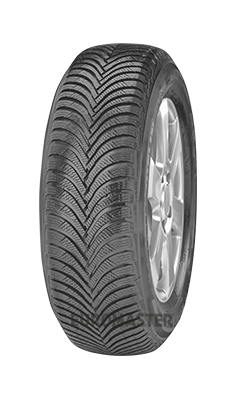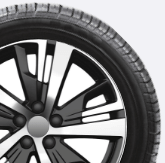
Looking for a winter tyre? The Michelin Alpin 5 offers excellent performance in snowy, icy and wet driving conditions

Winter tyres hold the road better when the temperature drops. On cold, wet or icy surfaces, regular tyres can lose traction. Winter tyres are built for these conditions and help you stay in control.
If you're not sure which tyres fit your car, we're ready to guide you. Our team will help you choose based on your usual routes and driving style. And with centres across the country, support is always close.

Below is a selection of our most popular winter tyres from leading tyre brands such as Michelin, Avon & Continental.

Looking for a winter tyre? The Michelin Alpin 5 offers excellent performance in snowy, icy and wet driving conditions

American tyre giant Goodyear presents its improved version of the already high performance UltraGrip 9. This new UltraGrip 9+ model provides compact vehicle drivers with even better braking, wet road grip, and driveability in winter weather.

Ideal for high performance SUV vehicles, the ContiCrossContact Winter delivers excellent traction and high braking performance.

Safety and comfort in all winter conditions

The Yokohama BluEarth*Winter V905 winter tyre offers drivers peace of mind when driving in wet or snowy conditions.

Designed for a large range of cars, the BFGoodrich g-Force Winter 2 winter tyre places the focus on efficient braking whether in wet or icy conditions.
When the temperature drops below 7°C, standard tyres start to harden. That means less grip, longer braking distances and less control. Winter tyres stay soft in cold weather, so your car holds the road better.
Cold, dry roads can still affect how your car handles. With the right tyres, steering feels smoother and braking becomes more responsive. Their deeper tread and narrow channels move water and slush away quickly, which helps the tyres grip the road.
Winter tyres are made with a special rubber that stays flexible in cold weather. This keeps the tyre in close contact with the road for better grip and shorter braking distances.
They also have deeper tread and small grooves called sipes. These push away water, slush and snow to keep traction on slippery surfaces.
Summer tyres go rigid when it’s cold and lose effectiveness. Winter tyres don’t. That’s what makes them a safer choice when temperatures drop.
The right tyres depend on the weather you face and how you use your car.
Summer tyres give their best in warm conditions. Their firm rubber and shallow tread offer strong grip and sharp braking on dry or wet roads above 7°C. In colder weather, they harden and lose performance.
All-season tyres suit drivers who want a single set for the whole year. They mix features from both summer and winter tyres, but don’t match the full benefits of a tyre designed for one season only.
| Feature | Summer Tyres | All-Season Tyres | Winter Tyres |
|---|---|---|---|
| Best temperature range | Above 7°C | Year-round | Below 7°C |
| Performance in snow and ice | Poor | Moderate | Excellent |
| Braking on cold roads | Reduced | Good | Outstanding |
| Ideal use | Warm climates | Mild winters | Cold and wet winters |
Once it stays below 7°C most days, you’ll benefit from switching to winter tyres. In the UK, this usually happens between late October and early November.
Colder conditions tend to set in earlier in northern regions and places at higher elevation. If you live or drive in Scotland or northern England, you will likely need to switch your tyres sooner. In the south, even if the weather stays milder a bit longer, early frost and rain still make winter tyres a smart move before winter properly kicks in.
You can switch to winter tyres before the first sign of snow. Once temperatures drop, they start to work better than regular tyres and help you stay safer while driving.
Simply search for your tyre size on line and filter to winter tyres to see what options are available. Then just book an appointment at date and time that suits you to get your new winter tyres fitted.
Winter tyres not only improve traction but can also reduce braking distances by up to 30% compared to summer tyres in cold conditions. This difference can be critical when you need to stop quickly on icy or wet roads.
If you're planning to switch to winter tyres, there's likely a centre nearby that can help. You can book your fitting online and choose a location close to home or work. The service is quick, and our team handles everything with care. If reaching a centre is not convenient, we can come to you. In many areas, our mobile team fits tyres directly on your driveway.
There’s no one-size-fits-all. The best winter tyres for you depend on what you drive, how you drive and where you usually go. A quick run around town isn’t the same as early starts on country roads.
A good place to start is the 3PMSF symbol. That’s the little mountain with a snowflake on it. This mark shows the tyre has passed tests for demanding winter use. You might also spot M+S on some tyres, but that doesn’t always mean they will perform well in tougher conditions.
If you’re unsure, the EU label on each tyre gives more detail. It shows how the tyre handles wet roads, how it affects fuel use, and how much noise it makes.
Still unsure about which tyre to choose? We can guide you. Some tyres work better on rural roads, others are designed for built-up areas. The right choice depends on your car, your budget and the kind of winter driving you face.
Winter tyres stay effective even at motorway speeds. Their special construction maintains stability and control at higher speeds on cold, dry or wet roads.
Yes. They help more than most people think. Even without snow, winter tyres improve grip and braking as soon as temperatures drop below 7°C. Cold, wet roads are much safer with the right tyres on.
No. There is no legal requirement to use them. But they are strongly recommended if you drive somewhere that gets cold or icy in winter.
Always go for 4. Fitting just 2 winter tyres creates an imbalance that affects how your car handles and brakes.
The price depends on your vehicle, the tyre size and the brand you choose. ATS Euromaster offers a wide range of options to suit different needs and budgets, all with transparent pricing and expert fitting.
They usually have a similar life span to regular car tyres and should last around 20,000-40,400 miles. However, due to their softer rubber compound, if you use winter tyres during the summer they're likely to wear out much quicker.
Because of their deeper tread, winter tyres can be slightly noisier than regular tyres.
Many people use both terms as if they mean the same thing, but “winter tyres” is the correct one. They are not just for snow. They are designed to work in cold weather, on wet roads, over icy patches, and even on dry roads when the temperature drops.
Although it isn't illegal to use winter tyres all year round, we don't recommend it. They are made from a special rubber compound that, in warm conditions, can become too soft, reducing traction and braking control. Using winter tyres in summer will also cause them to wear much faster, meaning you'll have to replace them much sooner.
No, it's not illegal to mix winter and summer tyres in the UK, but we strongly recommend against it. As they are designed to perform well in different conditions, summer and winter tyres are made from different rubber compounds and have different treads. Mixing these can cause stability and handling problems and may even invalidate your insurance. Therefore, if you're planning to buy winter tyres for the cold season, you should always install 4 instead of 2.
There's not much difference in fuel consumption between regular tyres and winter ones. However, using winter tyres in summer will use more fuel, as they will have a higher rolling resistance on warm roads.